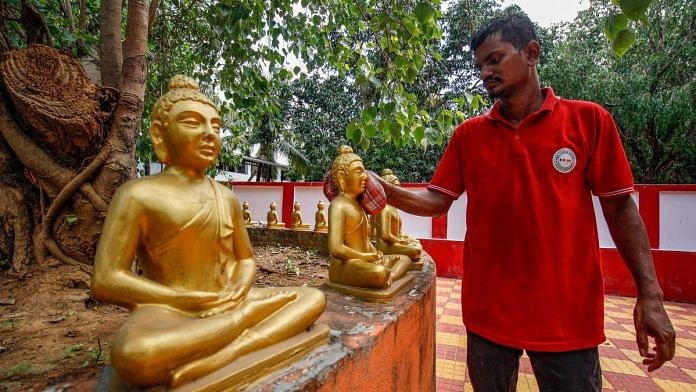Chennai: The Tamil Nadu government plans to set up its first Buddhist museum in Nagapattinam dedicated to showcasing artefacts and bronze statues of Buddha to highlight the state’s rich historical ties to Buddhism.
The move is likely to be announced during the upcoming Budget session in the Tamil Nadu Assembly, ThePrint has learnt. The session is expected to be held in February or March, though the dates are yet to be announced.
A senior state government official told ThePrint that the process of collecting Buddha bronzes excavated from Nagapattinam over the years was underway. The museum aims to showcase the region’s rich Buddhist history during the Chola period from the 9th to the 13th century.
“As of now, there are at least 30 Buddha bronzes kept in the Chennai museum that were excavated from Nagapattinam. But several of them have been distributed to various places,” the official said.
“We are in the process of taking stock of the available Buddha statues and tracing the distributed statues.”
Archaeologists and historians estimate that over the years about 350 Buddhist bronzes have been excavated from Nagapattinam, once a major Buddhist centre. A few of them are in museums in Lucknow, Kolkata and Mumbai, while some are in museums in London and Germany. Some are untraceable.
The official said that the initial plan was to establish the museum in Kanchipuram but the government chose Nagapattinam following the efforts of its MLA J. Mohamed Shanavas, who said setting up a museum showcasing the town’s Buddhist heritage would be a milestone in Tamil Nadu’s history.
“People following Buddhism in various countries visit Nagapattinam. We have a lot of evidence to show that Buddhism was once practiced in this coastal town. We have also excavated several Buddhist statues in the town, which are now preserved in various museums. Now, if they are all brought here, it would be great,” he said.
Nagapattinam was once a major centre for Buddhism before it began to decline in the 16th century and eventually disappeared.
Dr B Jambulingam, retired assistant registrar of Tamil University and author of Buddhism in Chola Nadu, welcomed the Tamil Nadu government’s decision to establish the museum in Nagapattinam, saying the move would help people know their own history.
“It’s a welcome move that the Tamil Nadu state government is displaying the Nagapattinam Buddha bronzes in the same town where they were excavated,” Jambulingam said.
Also read: A Tamil Buddhist yogi went to Zanzibar, Macau in 1500s. Changes what we know about Buddhism
Nagapattinam’s ties with Buddhism
The push for a museum began in March 2022 when Shanavas first raised his voice for its creation.
“Nagapattinam is not only a coastal and cultural town, but also a town where Buddhism flourished once upon a time. In excavations in the town, around 350 bronze Buddha statues were recovered, but we don’t know where they are. All of them have to be recovered and a separate museum should be set up to preserve them,” he said in the Assembly.
In 2023, based on his request, an Archaeological Survey of India (ASI) team led by Superintending Archaeologist K. Amarnath Ramakrishna conducted a three-day survey in Nagapattinam. The team submitted a report to the district collector, the regional director and the director of ASI.
According to this report, accessed by ThePrint, the team identified at least 19 places, including the current district court complex in the town, with archaeological and historical vestiges of Buddhism.
The team identified the district court complex—with its colonial building resembling a Chaitya Vihara, constructed after the demolition of a China Pagoda by Jesuit missionaries in 1867—as the most appropriate location for the exhibition to showcase the cultural legacy of Nagapattinam.
It said the site was a fitting spot as it recalled the historical significance of the Chudamani Vihara, an 11th-century Buddhist monastery in Nagapattinam.
The report said the initiative would promote regional cultural tourism in Nagapattinam and educate the public about the town’s rich Buddhist heritage.
According to Jambulingam, a large number of Buddhist bronzes recovered from Nagapattinam town belonged to the Chola period.
“Since 1856 CE, about 350 Buddhist bronzes of the Mahayana were recovered from vihara sites raised by the Sailendras of Sumatra in the time of the Chola king Rajaraja I and Rajendra Chola I. Some of these bronzes belong to the early Chola (871-1070 CE) time and a large number to the later Chola period (1070-1250 CE),” Jambulingam said.
“Some of the bronze sculptures are inscribed. Some are exhibited in museums in India and overseas. Some might have been sculpted in Nagapattinam and used for worship in viharas or Buddha temples. Such bronze sculptures found subsequently at Ayyampet, Sellur and Nagapattinam prove the existence of Buddhism in this area,” he added.
Jambulingam felt that establishing the museum would help preserve the history of Buddhism in the Chola region for generations to come.
“Taking the history of the people to the natives of the land is what will make the history live long. If not, it might be changed in the future for the convenience of the people who come to power,” he said.
Shanavas told ThePrint the museum would serve as a cultural centre for understanding the history of Buddhism in Tamil Nadu.
“Setting up a museum with the real history of the soil would rewrite the history of Buddhism in the Tamil land. With the available Buddhist statues and other artefacts, the upcoming museum would help people recreate their own history in the Buddhism narrative,” he said.
Also read: Nehru used Bodh Gaya to make India a culture superpower. ‘Navel of the earth’






